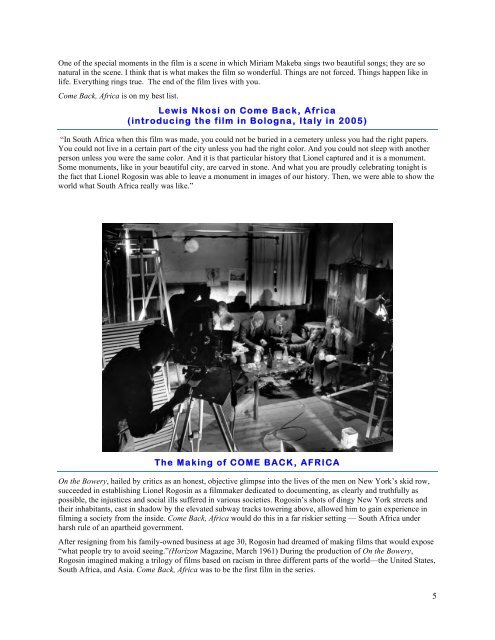Come Back Africa Press Kit - Get a Free Blog
Come Back Africa Press Kit - Get a Free Blog
Come Back Africa Press Kit - Get a Free Blog
You also want an ePaper? Increase the reach of your titles
YUMPU automatically turns print PDFs into web optimized ePapers that Google loves.
One of the special moments in the film is a scene in which Miriam Makeba sings two beautiful songs; they are so<br />
natural in the scene. I think that is what makes the film so wonderful. Things are not forced. Things happen like in<br />
life. Everything rings true. The end of the film lives with you.<br />
<strong>Come</strong> <strong>Back</strong>, <strong>Africa</strong> is on my best list.<br />
Lewis Nkosi on <strong>Come</strong> <strong>Back</strong>, <strong>Africa</strong><br />
(introducing the film in Bologna, Italy in 2005)<br />
“In South <strong>Africa</strong> when this film was made, you could not be buried in a cemetery unless you had the right papers.<br />
You could not live in a certain part of the city unless you had the right color. And you could not sleep with another<br />
person unless you were the same color. And it is that particular history that Lionel captured and it is a monument.<br />
Some monuments, like in your beautiful city, are carved in stone. And what you are proudly celebrating tonight is<br />
the fact that Lionel Rogosin was able to leave a monument in images of our history. Then, we were able to show the<br />
world what South <strong>Africa</strong> really was like.”<br />
The Making of COME BACK, AFRICA<br />
On the Bowery, hailed by critics as an honest, objective glimpse into the lives of the men on New York’s skid row,<br />
succeeded in establishing Lionel Rogosin as a filmmaker dedicated to documenting, as clearly and truthfully as<br />
possible, the injustices and social ills suffered in various societies. Rogosin’s shots of dingy New York streets and<br />
their inhabitants, cast in shadow by the elevated subway tracks towering above, allowed him to gain experience in<br />
filming a society from the inside. <strong>Come</strong> <strong>Back</strong>, <strong>Africa</strong> would do this in a far riskier setting — South <strong>Africa</strong> under<br />
harsh rule of an apartheid government.<br />
After resigning from his family-owned business at age 30, Rogosin had dreamed of making films that would expose<br />
“what people try to avoid seeing.”(Horizon Magazine, March 1961) During the production of On the Bowery,<br />
Rogosin imagined making a trilogy of films based on racism in three different parts of the world—the United States,<br />
South <strong>Africa</strong>, and Asia. <strong>Come</strong> <strong>Back</strong>, <strong>Africa</strong> was to be the first film in the series.<br />
5


